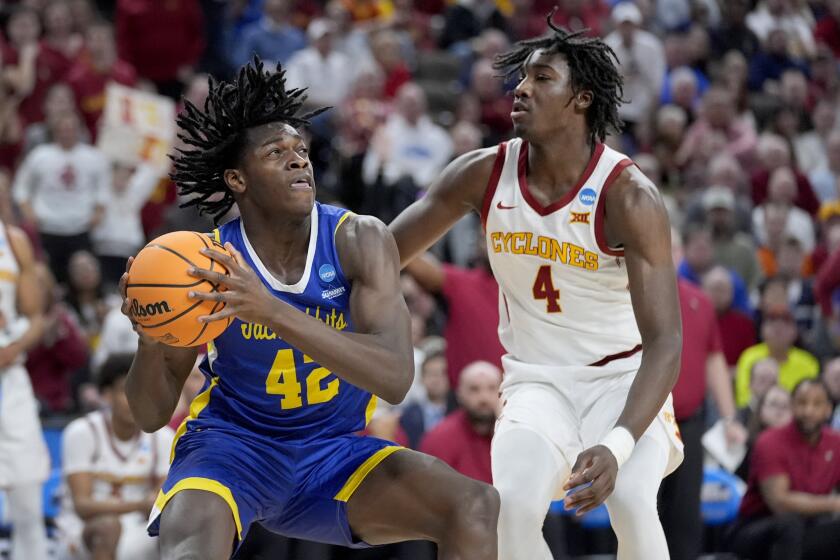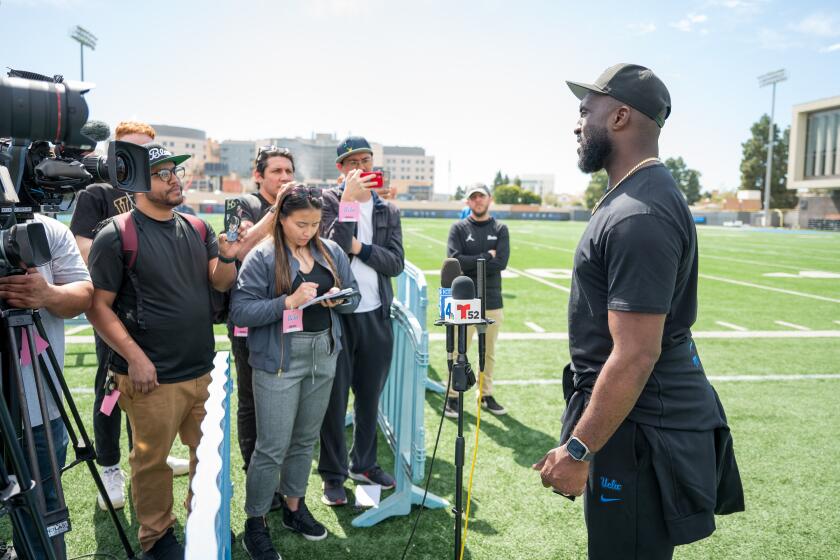The Guttiest Little Bruin
Gail Goodrich twists the fingers on those massive hands that fit perfectly around a basketball, such big hands for a 6-foot-1 body. He twists the fingers and looks up to the ceiling. His eyes close.
What is Goodrich seeing? The way Walt Hazzard would fake a shot and dish to Goodrich, who would drive and score? The way the UCLA Bruins ran their offense with synchronized brilliance, a silent choreography with the ball never seeming to touch the floor, the players seeming to fly above the court?
Whatever Goodrich sees, it has stopped him from speaking and brought tears to his eyes.
Finally, after three hard swallows, Goodrich whispers, “Yes.”
Yes, he will cry today. Yes, he will be proud today.
Finally, years after his induction into the Naismith Basketball Hall of Fame, after having his jersey number retired by his high school, Sun Valley Poly, and by his pro team, the Lakers, Goodrich will stand at center court in Pauley Pavilion where his UCLA No. 25 will be hoisted to the ceiling.
John Wooden, his coach; Jerry Norman, the UCLA assistant who was the first to be wowed by the skinny, left-handed guard at the city tournament; and Keith Erickson, teammate and friend, will join Goodrich. They will recall Goodrich as an excellent shooter, a fearless competitor who drove on players eight or nine inches taller and 100 pounds heavier, eager for the collision so he could shoot free throws. And Goodrich will cry.
“This means a lot to me,” Goodrich said. “It’s something I didn’t think would happen.”
It almost didn’t.
Goodrich, 61, will become the seventh UCLA men’s basketball player whose number has been retired, joining Hazzard (42), Kareem Abdul-Jabbar, formerly Lew Alcindor, (33); Bill Walton (32), Sidney Wicks (35), Marques Johnson (54) and Ed O’Bannon (31).
“I know Coach Wooden doesn’t really believe in having numbers retired,” Goodrich said, “but I think he put in a good word for me.”
In 1990, UCLA decided to retire the numbers of two men and two women -- Walton, Abdul-Jabbar, Ann Meyers-Drysdale and Denise Curry -- who had been the Bruins’ only three-time consensus All-Americans. In 1996, the school expanded the criteria to include those who were consensus national players of the year and retired the numbers of Hazzard, Wicks, Johnson and O’Bannon.
Goodrich’s absence from this list was glaring, though.
“He belongs of course,” said Erickson.
“What took so long?” said another teammate, Kenny Washington. “I mean, c’mon.”
When Dan Guerrero became UCLA athletic director three years ago, he had two questions: “Is there a reason why the court wasn’t named for Coach Wooden? And what is the rationale that is keeping Gail Goodrich from having his number retired?”
Last year, the Pauley Pavilion court was named for Wooden and his late wife, Nell.
This year, UCLA administrators decided that anyone who had been inducted into the Naismith Hall of Fame should be eligible to have his or her number retired.
“I don’t like to pick one over the other,” Wooden said. “It’s like with your own children. But Gail certainly had something special about him. Of course, he knows I’ve always been against retiring numbers. But since the practice was started, Gail should be there. Most definitely. Gail very much deserves this.”
Here’s what Goodrich’s UCLA teams accomplished:
* His freshman team was UCLA’s first to go undefeated.
* His junior team went 30-0 and won UCLA’s first national championship.
* His senior team also won the national championship and Goodrich had 42 points, at the time an NCAA championship-game and UCLA record, in the Bruins’ victory over Michigan in the national final.
* He was the leading scorer on Wooden’s -- and UCLA’s -- first two national championship teams.
* He left UCLA as the school’s leading scorer, with 1,690 points, and his 24.8-point single-season scoring average in 1965 is still No. 3 in school history and tops among Bruin guards.
Or, as Washington says, “Gail was a special booger. He was a little ol’ guy not supposed to do diddly squat. He was not highly recruited, that’s the beautiful part of the story. Nobody wanted him, that’s real. Nobody wanted him.”
Erickson agrees: “Gail was very much underappreciated. Going from high school to college, going from college to the pros, he was always supposed to be too small.”
Goodrich’s father, Gail, had been USC’s basketball captain in 1939 but the Trojans paid no attention to the little son until it was too late.
Wooden first picked him out at the Los Angeles City tournament when Goodrich was a junior.
“I’m watching his team play,” Wooden said, “and I notice this little left-hander, sort of small. I see he’s a junior and I say I’m going to be watching him. Somebody tapped my shoulder so I turned around and it was Gail’s mother, Jean.”
“My mom was all ears all the time,” Goodrich said. “She told Coach Wooden, ‘That’s my son you’re talking about.’ ”
That son was all of 5-8 and 120 pounds. He had a fantastic senior season too, grew to be 5-11 and 135 and at the end, USC and Cal tried to recruit Goodrich. It was too late.
“I had grown up sleeping with my dad’s USC letterman blanket,” Goodrich said, “but when my dad went to watch a Coach Wooden practice, he was amazed at the precision. My dad was a basketball junkie. He loved it.”
In Wooden, Goodrich found a coach who saw the game and the floor in the same way he did. In Goodrich, Wooden found an undersized boy with big hands and big heart.
Because of his respect for Wooden, Goodrich accepted it when he was told Hazzard would have the ball in his hands to start the offense.
“It was the right decision,” Goodrich said, “but no kid wants to hear that.”
When the Bruins went to the 1964 Final Four they were unbeaten and unappreciated, just like Goodrich.
“Two of the four teams, Kansas State and Michigan, we had already beaten,” Goodrich said. “Then we got Duke in the finals. They had two 6-10 players. Our biggest guys [Erickson and Fred Slaughter] were 6-5. There wasn’t the television coverage in those days. Most of the media saw us for the first time at the public workout, looked at how small we were and said, ‘How did they get here?’ ”
UCLA beat Duke, 98-83. Goodrich scored 27 points, the more-heralded Duke star Jeff Mullins 22, and the Bruins finished 30-0.
A year later Slaughter and Hazzard were gone, replaced by Doug McIntosh and Fred Goss. Sophomore Edgar Lacey had also moved into the lineup with Goodrich and Erickson. The Bruins lost a couple of games during the regular season but still went to the Final Four with Bill Bradley’s Princeton team, Cazzie Russell’s Michigan team and Wichita State. UCLA beat Wichita State in the semis and dominated Michigan in the final. Goodrich had his 42 points, compared to 28 for Russell.
“And Gail guarded Cazzie some,” Wooden said.
“Gail was deadly in that game,” Erickson said. “He had enormous confidence in himself, was single-minded in his preparation. He was absolutely fearless. It didn’t matter how big the guys were, he would take it right in there and come away with a basket or free throws. He was a deadly shooter.”
Even though he was supposed to be too small for the NBA, Goodrich played in the league 14 seasons. He was the leading scorer on the 1971-72 Laker team, averaging 25.9 points a game, and during the NBA-record 33-game winning streak that season, he averaged 26.8. He was a five-time NBA All-Star and once scored 53 points in a game.
Since retiring from the NBA in 1979, Goodrich, father of three grown children, has worked in real estate, organized the basketball venue for the 1984 Los Angeles Olympics and became vice president first of National Golf Properties and then president of National Fairways Inc., a company that acquires and manages golf courses.
Goodrich and his second wife, Toni, moved to Connecticut 12 years ago.
“I thought it was time for a change,” he said. “And for business reasons it made sense.”
He is also a studio analyst for NBA TV, doing one show a week. He says he “wouldn’t mind” being involved in a front-office capacity for an NBA team and that he loves watching Tim Duncan and LeBron James play.
Coach Wooden mentions that Goodrich’s belt size “may have increased” over the years but Goodrich looks as if he could still hit a few jump shots.
“Not really,” he said, rubbing his back. “I’ve got some aches and pains.”
All the members of Goodrich’s 1964 and 1965 teams have been invited to today’s ceremony, at Goodrich’s request. “That’s something I’m looking forward to,” he said. “It doesn’t happen often, getting the guys together.”
The significance of this honor happening on a day when UCLA plays Michigan isn’t lost on Goodrich either.
“That was a special day almost 40 years ago, scoring 42 points, going against Cazzie,” Goodrich said. “It’s kind of neat Michigan is involved again.”
*
(BEGIN TEXT OF INFOBOX)
RETIRED
UCLA NUMBERS
25 Gail Goodrich
31 Ed O’Bannon
32 Bill Walton
33 Kareem Abdul-Jabbar
35 Sidney Wicks
42 Walt Hazzard
54 Marques Johnson
**
Fill ‘Er Up
Gail Goodrich has the third-highest point total in a season at UCLA:
*--* Player Year Points Avg Lew Alcindor 1967 870 29.0 Reggie Miller 1986 750 25.9 Gail Goodrich 1965 744 24.8 Lew Alcindor 1968 734 26.2 Lew Alcindor 1969 721 24.0 Don MacLean 1991 714 23.0 Reggie Miller 1987 712 22.3 Tracy Murray 1992 706 21.4 Tracy Murray 1991 679 21.2 Ed O’Bannon 1995 673 20.4
*--*
Note: In three seasons at UCLA, Goodrich shot 47.6% from the field and averaged 19.0 points a game (1,690).
Go beyond the scoreboard
Get the latest on L.A.'s teams in the daily Sports Report newsletter.
You may occasionally receive promotional content from the Los Angeles Times.



